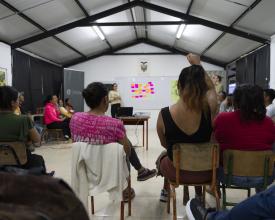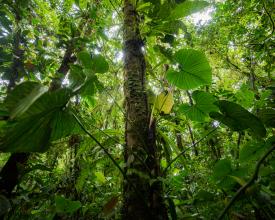
NFTrees for conservation

NFTrees is an innovative conservation financing model by Fundación Futuro that leverages blockchain, AI, and community governance to conserve and restore 195,000 hectares in the Andean Chocó. By tokenizing 10x10 meter plots using high-resolution carbon stock and biodiversity maps, NFTrees connects private-sector funds with local land stewards. This scalable, transparent solution addresses global challenges like deforestation, biodiversity loss, and climate financing gaps. Since 2019, it has channeled more than $800,000 into conservation efforts, creating sustainable economic incentives for smallholders while preserving critical ecosystems.
Context
Challenges addressed
NFTree addresses interconnected environmental, social, and economic challenges in Ecuador’s Andean Chocó.
Environmental: Over 50% of original forest cover is lost due to logging and land-use change, degrading biodiversity and carbon sinks.
Social: Smallholders lack long-term incentives for conservation, while communities face weak participation in land-use decisions.
Economic: Deforestation offers higher short-term returns than conservation. Rural communities lack access to climate finance due to complex verification and governance barriers.
NFTree bridges these gaps by combining traceable NFTs, inclusive community governance (DAOs), and digital MRV tools to incentivize forest stewardship and redirect capital toward nature-positive outcomes.
Location
Process
Summary of the process
NFTree is a conservation finance mechanism that integrates technology, governance, and incentives to protect and restore forests of high ecological value. The process begins with high-resolution biophysical mapping and digital MRV systems that generate trusted data on carbon and biodiversity. These data feed into a blockchain platform where conservation areas are tokenized into NFTs and made available for supporters to contribute. A DAO is established to govern fund use, engaging communities through co-designed statutes. Revenue is pooled in a fiduciary trust and disbursed through community-driven conservation agreements that prioritize restoration and protection. The process is designed to ensure transparency, local ownership, and long-term ecological and financial sustainability.
Building Blocks
Decentralized Local Governance via DAOs
NFTree promotes the formation of decentralized autonomous organizations (DAOs) that operate as governance bodies co-designed with landowners and local actors. These DAOs are formalized through statutes that outline voting rights, membership, responsibilities, and procedures for fund allocation and monitoring. In places like Guayabillas, the DAO is adapted to local contexts and integrates with existing instruments such as community meetings. These governance structures enable transparency, local prioritization of conservation areas, and collective oversight of restoration and MRV efforts. NFTree incorporates digital tools to manage the DAO on-chain, while also maintaining analog mechanisms when needed due to technological constraints.
Enabling factors
- Collective drafting and validation of DAO statutes with landowners and community stakeholders
- Local capacity-building workshops and onboarding sessions
- Integration of customary governance and ecological priorities
- Use of open-source platforms like Aragon for DAO governance
- Alignment with local conservation planning (e.g., management plans)
Lesson learned
- Participatory governance processes strengthen trust and long-term commitment
- Co-design of statutes enhances local legitimacy and clarity on rights and roles
- Hybrid digital-offline governance models improve accessibility and inclusion
- Transparent, consensus-based fund allocation boosts engagement and accountability
Resources
Blockchain-based Conservation Tokens
NFTree tokenizes plots of 10x10 meters within conservation areas, using blockchain technology to create unique digital assets that represent ecological value, including carbon and biodiversity indicators. These NFTs are embedded with monitoring data generated by the dMRV system and are linked to geo-referenced locations. Each NFT is assigned a traceable identifier and linked to the DAO governance model, which regulates the reinvestment of funds. The proceeds from the purchase of NFTrees are allocated through a fiduciary fund to support the management and restoration of priority areas defined by the DAO statutes.
Enabling factors
- Availability of high-resolution geospatial data and MRV systems
- Smart contract infrastructure on blockchain (Polygon, Cosmos)
- Established governance structure (DAO statutes)
- Legal and fiduciary framework for fund administration
Lesson learned
- Transparency in how tokens are defined and sold is key to user trust
- Combining scientific modeling with blockchain improves integrity
- Co-design with local actors ensures acceptance of tokenized units
- A legal trust ensures transparent fund allocation aligned with conservation goals
Resources
Digital Monitoring, Reporting, and Verification (MRV) System
NFTree deploys a robust Digital MRV system that combines satellite imagery, drone-based observation, artificial intelligence (AI), and community-sourced data to measure carbon stocks, forest productivity, and biodiversity. The system processes spatial and biophysical data using tools like Google Earth Engine and machine learning models to detect forest changes at high resolution. Community-based monitoring complements technological inputs to validate and enrich ecological datasets. This multi-source approach ensures transparent reporting, boosts credibility with buyers and donors, and enhances local engagement in conservation efforts .
Enabling factors
- High-resolution satellite and drone imagery, accessible through platforms like Google Earth Engine.
- AI models co-developed with academic and technical partners.
- Consistent local ground-truthing efforts.
- Digital infrastructure for data storage, visualization, and public access via platforms like nftree.com.ec.
Lesson learned
- Combining remote sensing with local monitoring increases accuracy and community trust.
- AI models require region-specific calibration and ongoing validation.
- Transparency and access to MRV data empower communities and improve funder confidence.
- Training for local actors is key to sustaining long-term monitoring efforts.
Community-Inclusive Conservation Incentives
NFTree’s conservation incentives model is built around community-led agreements that recognize and reward local ecosystem services. The conservation agreements define the restoration or conservation activities to be carried out and the criteria for incentive disbursement. By channeling resources directly to land stewards—especially in high-biodiversity zones—this mechanism ensures both the economic viability and ecological integrity of restoration efforts. The model also considers informal tenure arrangements and provides flexibility to include diverse property types, addressing one of the key implementation barriers in fragmented landscapes. Incentives are distributed periodically based on verified ecological performance through the MRV system, fostering continuous engagement and accountability.
Enabling factors
- Transparent fiduciary trust and incentive governance mechanisms
- Contextualized conservation agreements with smallholders
- Flexibility to include informal or collective land tenure arrangements
- Ongoing community support and monitoring mechanisms
- Robust MRV system validating compliance
Lesson learned
- Early community involvement in agreement design strengthens ownership and compliance
- Addressing tenure informality is essential for inclusive participation
- Periodic and performance-based payments increase motivation and continuity
- Trust and clarity in payment distribution processes are critical to avoid conflicts
Ecosystem-Based Economic Trade-Offs
NFTree seeks to make conservation economically competitive by increasing the opportunity cost of forest conversion. The model redirects resources toward conservation by integrating blockchain, MRV systems, and community incentives, channeling funds into a fiduciary trust. These funds are allocated based on territorial prioritization and community governance mechanisms that value the ecological function of native forests. Through this, NFTree offers an ecosystem-based alternative to traditional productive models such as extensive cattle ranching or extractive activities.
NFTree provides economic alternatives that make conservation viable and attractive. By assigning a financial value to conservation through tokenization and connecting it to real ecosystem services (e.g., carbon sequestration, biodiversity), the model enables a shift in local economic logic. Funds from NFT sales are funneled into a fiduciary trust and redistributed through community-designed conservation agreements. These agreements consider the ecological integrity of each territory and are managed collectively. As a result, economic activities shift away from degradation and toward ecosystem service provision, strengthening long-term sustainability and local resilience.
Enabling factors
- Integration of ecological, social, and governance dimensions in conservation finance
- Territorial prioritization based on conservation value and risk of deforestation
- Financial trust structures to ensure transparency and equitable fund use
- Local validation of conservation agreements tailored to each territory’s dynamics
Lesson learned
- Financial incentives are most effective when aligned with local priorities and governance
- Community involvement from early stages increases legitimacy and impact
- Economic models must be flexible to adapt to the heterogeneity of territories and stakeholders
- Continuous MRV is essential to maintain confidence and ensure long-term viability
Impacts
NFTree has delivered robust environmental, social, and economic outcomes.
- Environmentally, over 195,000 hectares of forest in the Andean Chocó have been mapped for conservation and carbon sequestration. The digital MRV system tracks carbon stocks, forest productivity, and alpha-diversity trends, ensuring transparency and ecological integrity.
- Socially, the establishment of DAOs has empowered 26 landowning families through participatory governance models, reinforcing sustainable land-use and equitable fund distribution.
- Economically, the platform mobilized support from 8 private sector companies, resulting in $803,220 committed to conservation activities. The first stage aims to deliver $70/year/ha to participating families .
Beneficiaries
Local communities are primary beneficiaries, gaining financial incentives, capacity building, and security of land tenure through conservation agreements. Corporate actors benefit by offsetting emissions and aligning with ESG goals. Biodiversity and ecosystems
Additionally, explain the scalability potential of your Solution. Can it be replicated or expanded to other regions or ecosystem?
NFTree’s solution is highly scalable and adaptable. Its blockchain-based conservation model, decentralized governance through DAOs, and robust MRV system can be implemented in other biodiversity hotspots. The program is designed to expand from 1 pilot DAO to 15 communities and beyond the location, and its approach can be replicated globally, aligning with local ecological and social contexts.
Global Biodiversity Framework (GBF)
Sustainable Development Goals
Story
NFTree: “Integrating Conservation into Business Models to Amplify Impact”
In October 2024, Fundación Futuro, the sustainability arm of Grupo Futuro, hosted an event in Quito highlighting the success of NFTree in integrating conservation into business models. Business leaders, decision-makers, and environmental advocates gathered to explore innovative approaches for financing conservation.
Miguel Sevilla, Chairman of Fundación Futuro, emphasized the private sector’s responsibility to align business models with societal and environmental stewardship. He noted Grupo Futuro’s dedication to a dignified and sustainable society, supported by Fundación Futuro’s initiatives.
Carolina Proaño Castro, Executive Director of Fundación Futuro, presented NFTree as a transformative tool for addressing climate change and biodiversity loss. She showcased its impact: conserving 8,840 hectares of forest, sequestering 95,540 tons of carbon, protecting 1,350 species, and directing $803,220 toward conservation, benefiting 14 communities.
A panel featuring Eduardo Izurieta (CEO, SaludSA) and Maria Cecilia Alzamora (VP, Metropolitan Touring) highlighted how NFTree tokens integrate into corporate strategies. Eduardo shared how NFTree supports conservation through SaludSA’s Vitality platform, while Maria Cecilia showcased Metropolitan Touring’s commitment to preserving iconic regions like the Andean Chocó.
The event concluded with a stirring address by Roque Sevilla, Founder of Grupo Futuro, underscoring ethics, courage, and Ecuador’s unique advantages. Awards recognized companies integrating conservation into their business models, inspiring others to follow this impactful path.



